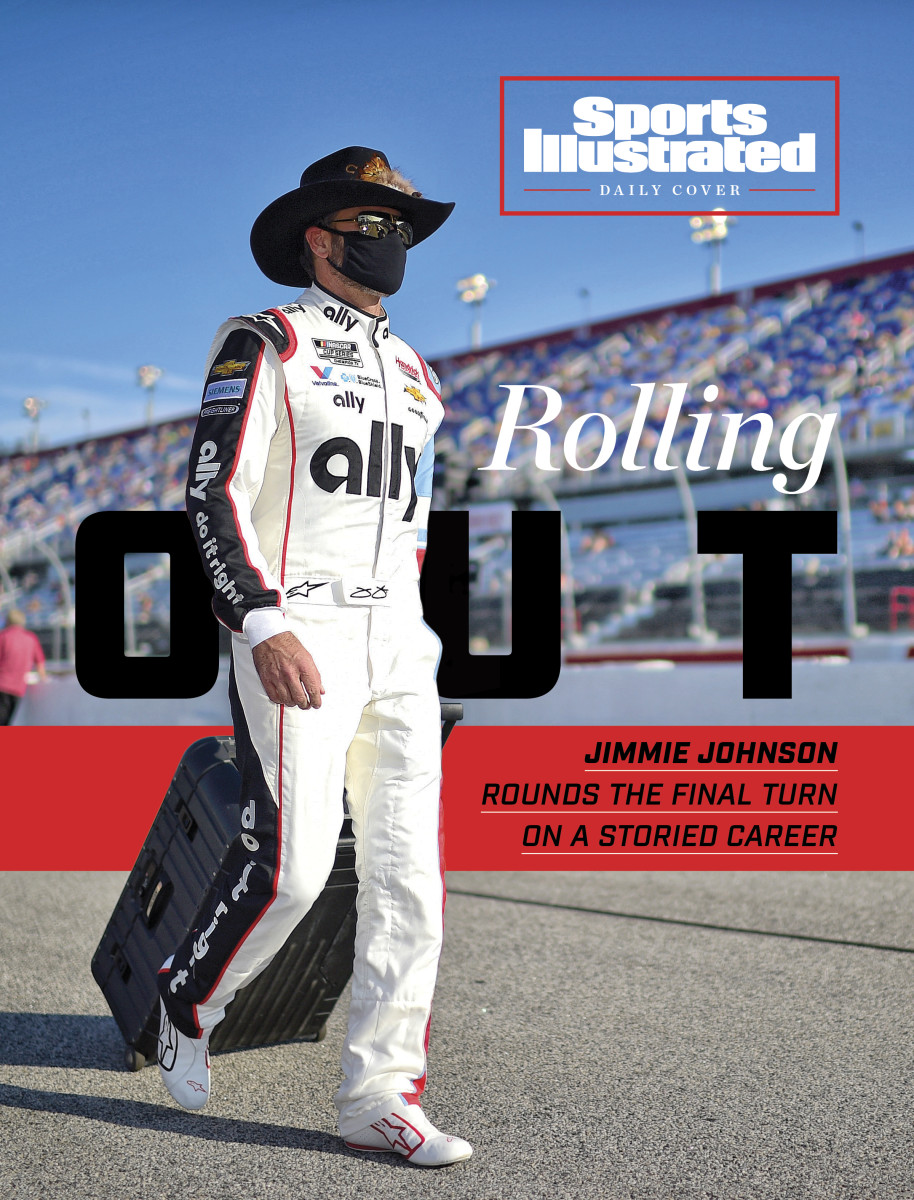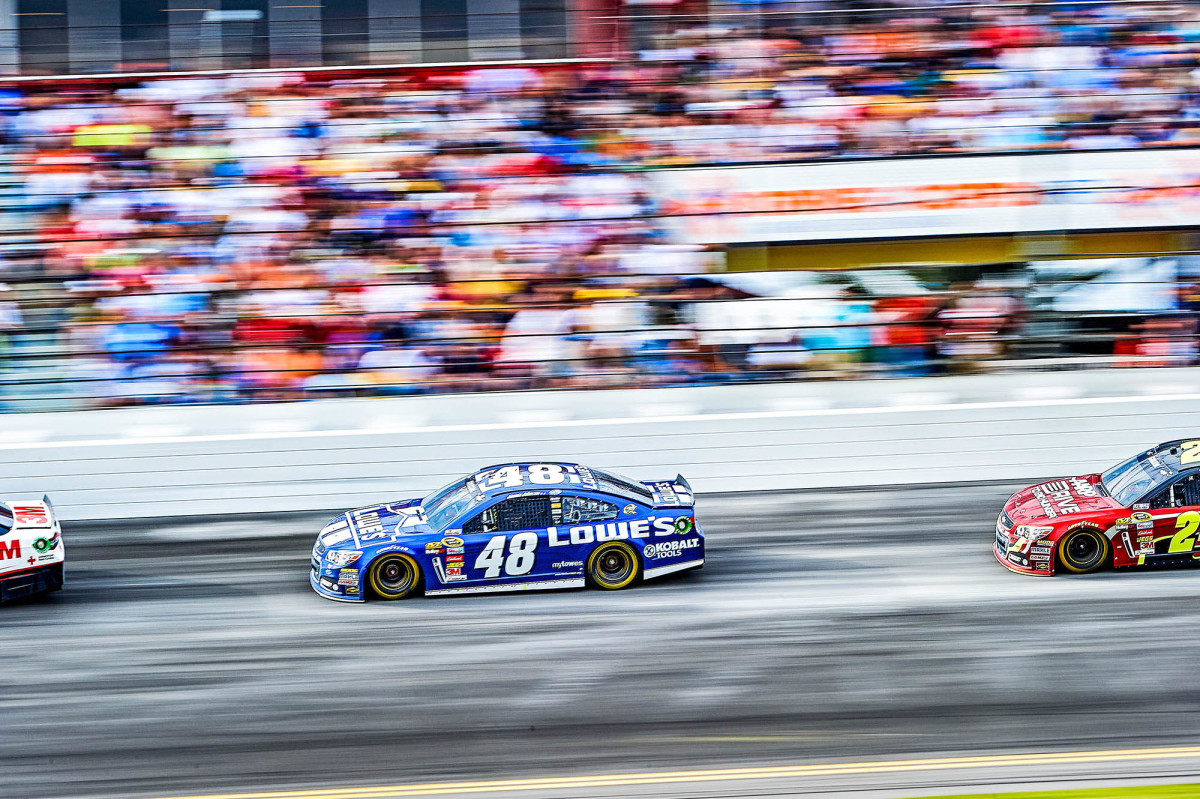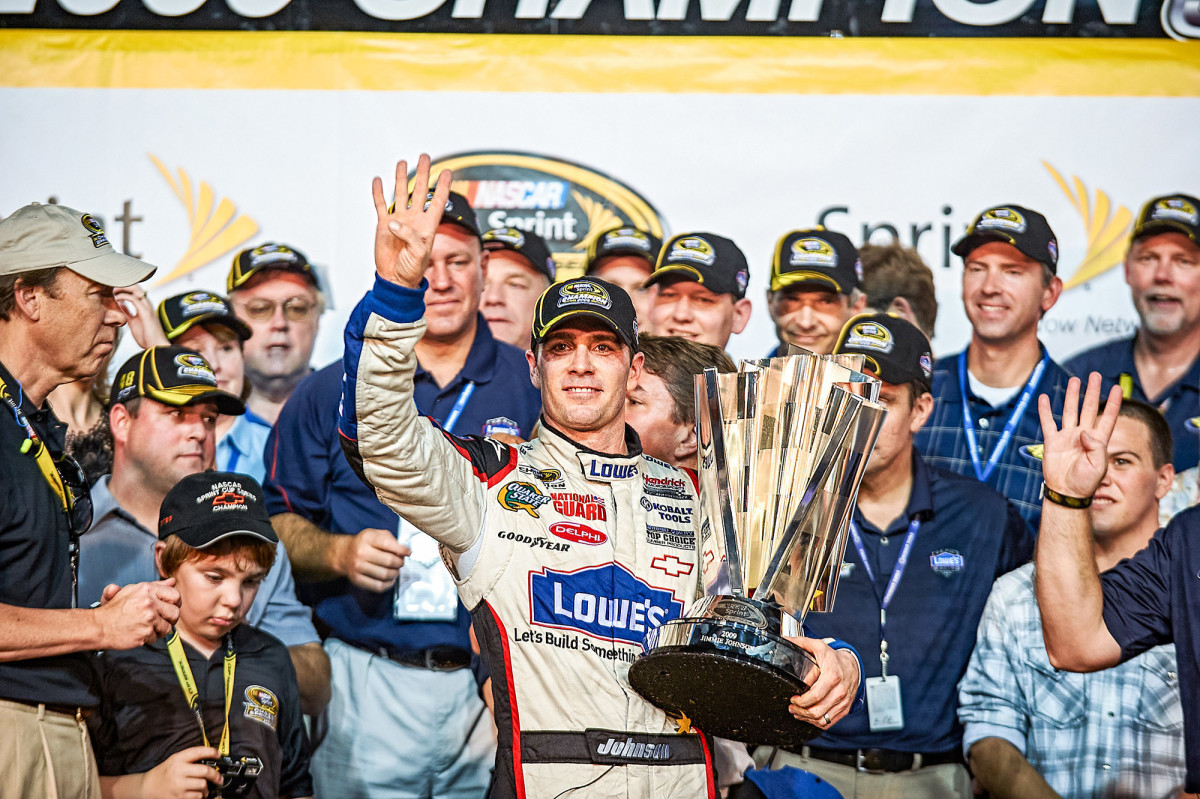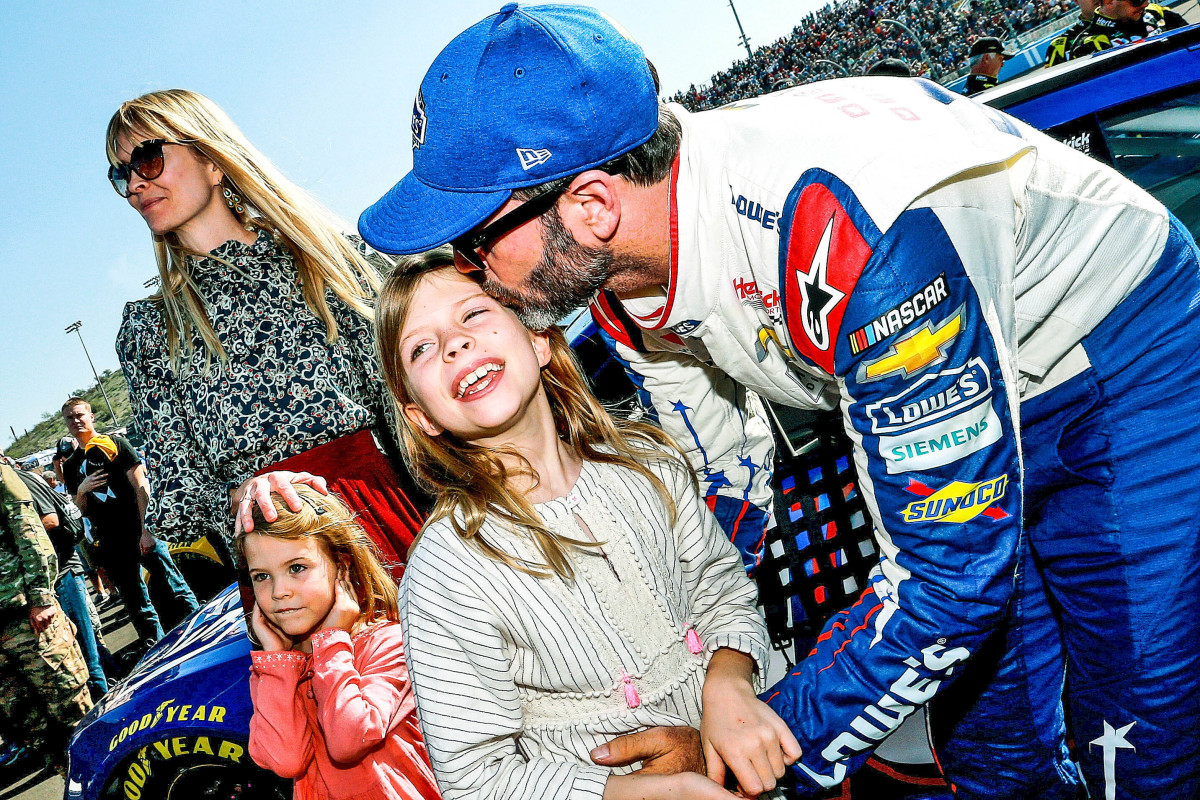Jimmie Johnson May Be Done With NASCAR, but Not Auto Racing
Richard Petty, Dale Earnhardt and Jimmie Johnson: One of these things is not like the others. All three own seven NASCAR season championships, but only one did not grow up in North Carolina as a second-generation stock car racer. The third grew up in California racing motorcycles and surfing.
With mentor Jeff Gordon (who both brought him into the fold at Hendrick Motorsports and later memorably complained after a string of on-track entanglements—alluding to his mentee’s championship count—that “Four-time expects to be treated differently”), Johnson exemplifies the changing demographics of NASCAR.
When he made his debut in 2001, just three drivers from outside the South had won a season championship. Now, as Johnson completes his 20th and final season, he is one of 12 interlopers with a title.

Johnson leaves NASCAR as the only man to win five titles in a row, and his 83 wins (assuming he doesn’t sneak into victory lane before the season finale on Nov. 8) are sixth-most in Cup Series history (and 10 fewer than Gordon’s 93). His final season saw him miss the playoffs for the second time in a row. While he didn’t get the full farewell he deserved, he was feted at several tracks, including New Hampshire Motor Speedway, where he was presented with a commemorative revolutionary musket in August. He isn’t retiring, though. Next year Johnson will drive a road-course-only schedule for Chip Ganassi Racing in the IndyCar series. Sports Illustrated talked with him as he was preparing for his final NASCAR races.
SI: What was it like having a farewell tour with hardly anybody to say goodbye to?
Jimmie Johnson: It’s not what I expected by any means. I feel for my die-hard fans who had big plans to see me in some final races. I feel terrible for my own family. My wife and children have not been to a race since Fontana at the beginning of March.
For me out there in the car, that experience is separate, and I’m disappointed that we haven’t been more competitive and we haven’t been to victory lane yet this year. So, 2020—I hope we can hurry up and get through it and we can reboot for ’21.
SI: You did get a custom-designed colonial musket out of the deal though, right?
JJ: And the Southern-most tunnel [at Homestead-Miami Speedway, named in his honor], which is . . . nice.
SI: Have you fired it?
JJ: No, I have not fired the musket. I have a man cave—it’s hanging up in there.
SI: We saw Bubba Wallace running a Black Lives Matter car this year and a lot of other drivers stepping up and voicing their support—not for just Bubba and BLM, but for issues such as getting rid of the Confederate flag at tracks. What does that say to you about how the sport has evolved since you got into it 20-some years ago?
JJ: It’s been a big year for our sport to grow, and I have to commend NASCAR leadership. I have to commend the drivers and everybody collectively wanting to have a voice and to be involved. Some would say this is the most progressive year our sport has had on that front, and I’m proud to be a part of that. I feel like the growth inside the sport has been there for a long, long time, but toward the public we crossed a few bridges that should have been crossed a long time ago.

SI: When you were at Darlington in September, you were wearing Richard Petty’s hat and Dale Earnhardt’s sunglasses. Those were the real things, right?
JJ: The glasses were actual Dale glasses. The Petty hat was a replica that Richard gave me in 2008 at a race. [For the sunglasses], I talked to Dale Jr. And he spoke to his sister, who spoke to his aunt, who had the sunglasses. So his aunt—she’s somewhere in Virginia—drove them down to North Carolina and Greg Ives, the crew chief on the 88 car, was at the go-kart track with his kids. The handoff happened there, then Greg drove the glasses from the go-kart track to Darlington. And they were sitting on the doorstep of my bus.
SI: What would it have meant for you to pass those guys to get your eighth championship?
JJ: In my heart of hearts, I never dreamt of winning a championship, so I really just enjoyed the ride along the way. You know, we went one, two, three, four, five in a row. I’m just like, Holy smokes. So I kept moving the goal line.

SI: Is there a part of you that thinks it’s almost cooler that you’re tied with them—that you’ll always be mentioned with them as part of your own little clique?
JJ: Yeah. I’m very good with it. I mean, as a competitor, of course I want to be the only one [with eight]. It never stops when that competitive piece kicks in. But I’m so proud to be with the King and the Intimidator. Who could ever dream that big, you know?
SI: Growing up in California at a time when NASCAR was still a pretty Southern thing, what did those names mean to you?
JJ: I knew the names. But the way we consumed media and the way I checked in with motorsport was really by going to races or occasionally catching a glimpse of it on Wide World of Sports, when they would show four or five different sporting events and you’d tune in quickly for a little bit of NASCAR. Then it would move to gymnastics and I’d walk out the house, come back and try to catch NASCAR again. I was able to see Petty in person at a race at Riverside, Calif. The blue 43—I saw him go by and I was like, Wow, I saw the King go by.
And then with Dale, that media was a bit better, but my brother was a Dale Earnhardt fan and there was no chance that we could ever get along about anything. I was a Jeff Gordon fan and so we had our rivalry inside the house.
SI: So when you were eight or 10, who did you want to be when you grew up?
JJ: I grew up on two wheels. All of my heroes were racing on dirt, from either the motocross scene or the off-road industry. My heroes were all two-wheel guys when I was eight. [The biggest one was] Rick Johnson.
SI: What was it like to go from being a Gordon fan to being his friend, colleague and competitor?
JJ: I’ve bought one piece of licensed merchandise in my life, and it was a Jeff Gordon 24 car that sat on the headboard at my house growing up. I watched him on Thursday Night Thunder and watched him through midget sprint cars, the Busch series, all of that. He was an inspiration for me—a California dirt racer who was making it work on the asphalt. He opened up doors for Tony Stewart, Kasey Kahne and Jimmie Johnson. I mean, I thought the guy could walk on water, and then I come to find out that he knows of me and is willing to put money down to start a race team for me to drive. It was a wild first couple of years. And before I knew it, I found myself in a heated rivalry with him racing for wins and championships.

SI: It must have been strange having ups and downs with someone you had admired so much.
JJ: I think it was probably harder for him in some respects. And then I would be a step behind at least in recognizing the burn that some of this competition was causing. But he’s been very open and honest and transparent with me, and our relationship, our friendship is built on that. We worked through some tough competition issues and we’re still in a great spot today. I’m thankful. He’s very much part of the reason why I met my wife. So personally and professionally, it’s been a big part of my life.
SI: When basketball players get older, they can’t jump as high. Football players break down. What happens with drivers when they get older? How do you feel physically?
JJ: I feel as good physically as I ever have. Photos will show that I’m in better shape than I was when I entered the Cup Series. So in that respect, we’re very lucky that we don’t have the wear and tear that the stick-and-ball guys have. But there’s absolutely something that goes—I don’t know what that is. I don’t want to believe anything is gone from me other than my patience for doing B.S. things around the sport. You know, my fuse is much shorter with a lot of the asks that are made.
SI: Not this, of course.
JJ: Of course not [chuckles]. But, you know, when I look at my friends that have retired—Gordon, Junior, Stewart— those guys were just ready to be done, and I’m not ready to stop driving. The rest of the stuff that goes with it, I can slow down. But the driving is still the best part. I’m not over that part yet. I still have more to do.
SI: What do you hope to get out of racing IndyCar?
JJ: I’m trying really hard not to put too much pressure on myself, at least in year one, on performance. This is more about experience. This next chapter in life for me is doing bucket list items. As a kid, I wanted to be an IndyCar driver. And after driving a Formula One car a few years ago in Bahrain and driving an IndyCar again recently in July at Indianapolis—they are just a blast to drive. I want to do more of that.

SI: But you’re not doing ovals. Is that just that you’ve been there, done that?
JJ: I have. And then Texas and Indy are just so fast. Maybe in ’22 or beyond, I would consider it. But right now I just feel good about the road courses. I know the risk factor I’m taking getting into an IndyCar on a road course. I’m just not ready to cross that bridge for Texas and Indy.
SI: What’s your training been like for IndyCar? A lot of simulator stuff?
JJ: That’s just getting ready to ramp up. Next week I get to hop in a SIM. We have some testing in November that will hopefully stay scheduled without COVID-19 issues. So we’re just kind of getting into it. But from a physical fitness side, NASCAR-wise, the races are longer and less intense, so I’ve been much more about endurance training, anaerobic threshold and spending a lot of time in that aerobic window. IndyCar is much more interval-style training—shorter duration, higher output. I’m getting my body going now. Instead of long runs, long rides and a little bit of weights, it’s now more weights, more interval stuff in shorter rides and runs.
SI: What are the odds that we see you back in NASCAR at some point, that you either pull a Mark Martin and unretire or just decide you want to dip your toes back in?
JJ: I think it’s more of a toe dip. With the rules package and where NASCAR’s going . . . you know, I want to drive stuff with way too much horsepower. And that’s definitely not the direction the [Cup] cars are going. But I love the sport and I want to be around. I want to be involved. I’m totally open to moonlighting.
